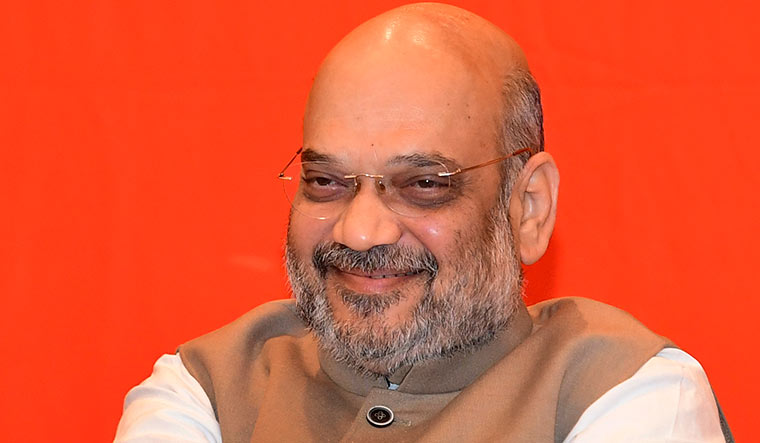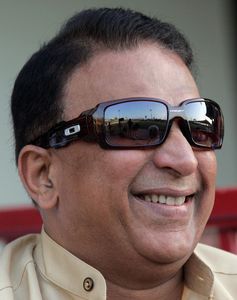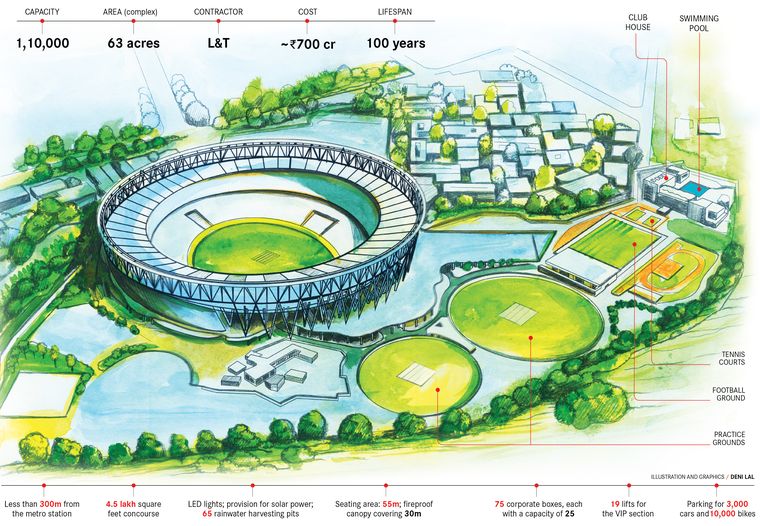The world’s largest cricket stadium is the legendary Melbourne Cricket Ground. In a few months, another MCG will take the crown. The Motera cricket ground in Gujarat is expected to seat 1.10 lakh people; the Melbourne stadium can hold 1,00,024.
The new stadium is expected to grab eyeballs the way the Statue of Unity, the world’s tallest statue at 182m, did early last year. The stadium, costing Rs700 crore and set over 63 acres, is in its final stages of completion.
The idea to rebuild the old Sardar Patel Stadium, which had a capacity of about 50,000, came up months before then chief minister Narendra Modi was to leave for Delhi in 2014, to start his new role. “When we discussed with him rebuilding the pavilion end, he asked us how old the structure was,” Parimal Nathwani, former senior vice president of the Gujarat Cricket Association, told THE WEEK. “When I said it was 25 years old, [Modi] said it would be better to come up with a new stadium.” When Modi was informed of the MCG’s seating capacity, he apparently told the GCA to build more seats.
The Sardar Patel Stadium has, over the years, seen many a record being broken. Be it Sunil Gavaskar becoming the first batsman to go past 10,000 Test runs or Kapil Dev overtaking Richard Hadlee with his 432nd scalp.
“I loved playing there,” Gavaskar told THE WEEK. “There are no fans more ardent than Gujaratis and Bengalis.” He also hoped the improved infrastructure would ensure quick emptying of the stadium, which would ease traffic jams. He also said he was looking forward to visiting the new stadium.
Former Indian opener Anshuman Gaekwad, who played the first match in the stadium—India versus the West Indies in 1983—said the new stadium was a brilliant achievement. “I have fond memories of the place,” said Gaekwad, who stayed in the club house of the stadium for six years as a GCA consultant.
The stadium has also seen some lows, particularly in administration. In 1992-93, when former deputy chief minister Narhari Amin took over as GCA president, the association was in debt; it had to pay Rs11 crore to various parties involved in building the stadium. “The bank balance was only Rs356,” Amin told THE WEEK.
As a fund-raising exercise, the Aamir Khan-starrer Sarfarosh was shown at the nearby drive-in theatre that could accommodate 700 cars. The GCA had booked the theatre and the money made was used to ease the debt. The GCA also brought out a souvenir to make more money. About Rs60 lakh was raised. “The GCA was probably the first cricket association that raised money not through cricket, but in such a manner,” said Amin.
Fast forward two decades, and money is not a problem for Indian cricket. Which is why Populous, the company that designed the MCG, was roped in for the new Motera stadium. The GCA brought on board Larsen & Toubro to execute the design and STUP Consultants to monitor the project. There is also a team of 25 professionals supervising the work.
A key highlight of the new stadium would be its connectivity to the metro station. “The stadium is less than 300m from the metro station,” said Nathwani.
The earthquake-proof structure will also have a unique lighting system. “Unlike the floodlit light poles in the stadium complex, we will have LED lights all over the stadium,” said Nathwani.
He said that Home Minister Amit Shah, who became GCA president once Modi moved to Delhi, insisted on transparency and quality of work, especially with the Supreme Court-appointed Justice Lodha committee keeping an eye on proceedings.
When the tender was floated, a key criteria was that the company should have an annual turnover of Rs2,000 crore for three consecutive years and experience of building a stadium. Apart from L&T, the Shapoorji Pallonji Group and the Nagarjuna Construction Company bid for the project.
The GCA had Rs300 crore and took a bank loan of a similar amount. It plans to raise Rs150 crore from the corporate boxes and an equal amount from the club membership, which is likely to be around Rs7 lakh. Around Rs75 crore could come in from the Board of Control for Cricket in India.
Nathwani said the association expected to settle the loan in about three and a half years after matches began; 92 per cent of the work is over and the stadium is expected to be ready in about six months. First match: a T20 between World XI and India.
Shah told THE WEEK that the new stadium would be the pride of India. This project is the vision of Prime Minister Modi, he said, adding that it was his dream that India had the world’s largest cricket stadium. “Our endeavour at the GCA is to work in the best interest of cricket and to ensure that India continues to retain its leadership of the game,” said Shah.
“It is nice to have the largest cricket stadium,” said Hitesh Patel, a fan in Ahmedabad. “The focus should remain on cricket and how budding cricketers can be nurtured.”
Given that Gujarat has recently produced a string of international players, including Jasprit Bumrah, Hardik Pandya and brother Krunal, better infrastructure will only add to the state’s cricketing legacy.





